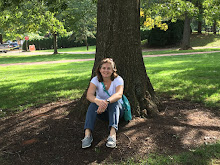Friday, May 27, 2011
Friday, May 20, 2011
Learning, Mastery and Communicating Ideas
I want to begin this post with a quote from one of my all-time favorite books on art for children (and adults) Doing Art Together by Muriel Silberstein-Storfer.
When anyone learns to ride a bicycle, usually after much effort on the part of both the guiding person and the beginner, he or she rides at first for the sheer joy of making the bike move and pleasure in controlling it. When the bicycle finally becomes a vehicle for exploration, transportation, and adventure, it is an instrument of new experience. Similarly, when anyone starts to work with art materials, he or she experiences this same exhilaration of moving the medium and controlling the brush and colors. After gaining control, studio work becomes involved with movement or communication of ideas.
This metaphor is a great illustration of the learning that happens when children are allowed an open-ended environment and opportunities to explore media. Each moves through the developmental stages of art in his or her own time and many have a favorite way of working that often precedes important new risks and adventures in communication and meaning.
Below are 3 paintings completed in one afternoon.
In this case the paintings were completed during our warm-up time, we offer a circle drawn in pencil on the page as a starting point. This mandala form provides a starting point for kids and a common routine to begin exploration of different media.
This young artist is very tactile and really enjoys exploring the sensory quality of materials and the flowing nature of the paint. The painting on the left, completed first is typical of his paintings in class. The page is full of color and brush strokes are clear moving through the thick paint.
Above, the artist begins his first painting with some awareness of the circle. As he continues in the picture below the joy of just moving the flowing colors takes over and he covers the page.
The third painting of a face was a real step forward for the artist in choosing to do a representational image and to follow through on his idea to paint a portrait. He began with eyes, nose and mouth.
His second painting shows a bit more awareness of the shape on the page. There is still the characteristic blocks of color and visible brush strokes but a beginning of shaping the painted strokes to the circle shape.
Other children at the table chose to use the circle form to paint faces. While working on his second painting, the artist began to talk about painting a portrait of his friend from school. The awareness of the circle seemed to be a first step toward thinking about a face.
The third painting of a face was a real step forward for the artist in choosing to do a representational image and to follow through on his idea to paint a portrait. He began with eyes, nose and mouth.
He added the hair and finished with the neck and ears, narrating as he added each detail.
The series of paintings below are a lovely illustration of moving from the pure joy of materials to beginning to communicate ideas - in this case to portray a friend using those materials.
Internship: A guide on process comments...
Anna has written a great guide for parents on what to say when children are working with art materials. click the link below to visit her internship blog and read more.
Friday, May 6, 2011
Building a Boat and Seeing it Float
Over time as children come to the studio for a weekly class, they begin to bring ideas with them from school, daily life, and important events. In this case, a young artist saved a small clear container from her snack at school with plans to use it in the after school studio.
Here the artist uses tape to secure a popsicle mast into the container.
A friend is excited to help her test the boat in a tub of water - it floats!
At the end of class we share about our creative process - in this case a demonstration is in order.The entire group gathers to see the boat sail around the bin!
Subscribe to:
Posts (Atom)

